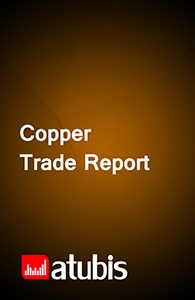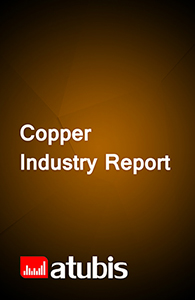Iran’s Copper Mine Market Outlook Report
9,743€
- TRY: 475,000 ₺
Output from copper ore processing includes concentrates, SXEW cathode, or cement copper. Copper concentrate is produced in concentrators that use sulphide ore as feed. SXEW cathode is produced in hydrometallurgical plants using oxide ore as feed. Cement copper is produced in hydrometallurgical (cementation) plants that can use oxide ore or copper scrap as feed. Copper concentrate in Iran’s market has an average grade between 24% and 26%; yet some mines such as Ghale Zari with relatively higher gold and silver content produce copper concentrate with a grade of 15%. Cement copper in Iran, like global markets, does not have a significant share and the grades are between 69% and 71%. Finally, SXEW cathode is produced according to global standards with 99.99% grades, which is equivalent to the LME’s grade A cathode.
Product Description
With a GDP of $415 billion in 2019, Iran was the third largest economy in the region that year. While the country’s economy was steadily growing after the drop in 2012 due to the sanctions, it dipped once again in 2019 thanks to the return of the sanctions. Due to its rich copper reserves, the country is the largest copper producer in the region; in 2019, the country was ranked the sixth largest in terms of copper reserves and the fifteenth largest copper producer in the world. But considering the capacity being built in the country, the rank in copper production can improve.
Market drivers of Iran’s copper production
The National Iranian Copper Industries Co. (NICICO) is the only large copper smelter in Iran, which is also the largest copper producer. Other smelters are mostly in the private sector, with smaller market shares; raw materials used by these smelters partly consist of copper scrap. NICICO’s plans are focused on ramping up cathode output, which will boost demand for concentrate.
Capacities in Iran’s downstream copper are so great that cathode demand is beyond domestic output capabilities. However, only part of these downstream capacities is operating to meet domestic demand for semis, without any contribution to exports. This will strengthen demand for copper as raw material for cathode production.
In the Iran Vision 2025, cathode output target is set at 700,000 tonnes per year. This will drive development in the smelting industry and create an opportunity for the mining sector to take advantage of the resulting demand. Based on goals set by the government for cathode production, the government is expected to offer stimulus such as loans and credit to investors, supporting concentrate demand.
Overview of Iran’s copper market
With the copper reserves in Iran thanks to the Middle East Copper Belt from the northwest to the southeast of the country, copper production has a long history in the country. Concentrate and SXEW cathode production, like elsewhere in the world, constitutes the largest share of output. NICICO is the largest producer of concentrate and SXEW cathode in Iran. The company has created massive copper smelting and refining capacities, which will boost demand for copper, especially concentrate. Thus, copper mine production is expected to increase and improve the country’s rank.
Breakdown of Iran’s copper market
Since cement copper has a small share in Iran’s market and is mostly produced from scrap, the copper market can be broken down into sulphide concentrate and SXEW cathode.
Key players in Iran’s copper market
- National Iranian Copper Industries Co (NICICO)
- Iranian Babak Copper Co
Additional Information
| Industry | Copper Mine Products |
|---|---|
| Region | Iran |
| Report Type | Industry Report |
Specifications
| Report Attribute | Details |
| The base year for estimation | 2021 |
| Historical data | 2011-2020 |
| Forecast period | 2021-2026 |
| Quantitative units | Value in USD and Volume in Tonne |
| Report coverage | Market Overview, Dynamics, Market Outlook, Risks to Forecast, Consumer Market, Industry Overview, Market Landscape, Competitive Landscape, Market Attractiveness, External Macro Environment Analysis |
| Segments covered | Composition, Type, Application |
| Pricing and purchase options | Please explore our purchase options to meet your exact research needs. |
Reasons to Buy
- Recognize the geographical distribution of import demand
- Identify the current and future key players of the trading market
- Achieve a better insight on potential target markets
- Understand the behavior of major suppliers/customers either globally or regionally
- Identify competitors as a feed for market analysis
Table of Content
1- Executive summary
2- Introduction
2-1- Objective
2-2- Market under study
2-3- Product
2-3-1- Product specifications
2-3-2- Consumption structure
2-3-2-1- Applications
2-4- Physical properties
2-5- Subjects discussed
2-6- Geographical scope under study
2-7- Study timeframe
2-8- Study currency
2-9- Potential audience
3- Market dynamics
3-1- Market drivers
3-2- Restraints
3-3- Opportunities
3-4- Challenges
4- Market overview
4-1- Market size
4-2- Industry capacities
4-2-1- Existing capacities
4-2-1-1- Capacity distribution
4-2-1-2- Geographical distribution of capacities
4-2-2- Future capacities
4-3- Output
4-3-1- Output trends
4-3-2- Operating rates
4-4- Consumption
4-4-1- Consumption trend
4-4-2- Consumption Share of domestic product
4-5- Trade
4-5-1- Exports
4-5-2- Imports
4-5-3- Trade balance
4-5-4- Market balance
4-6- Market breakdown by product type
4-7- Market breakdown by product type
4-8- Market breakdown by application
4-9- Inventory
4-9-1- Producers inventory
4-9-2- Consumers inventory
4-9-3- Traders inventory
5- Market outlook
5-1- Market factors
5-1-1- Raw materials
5-1-2- Costs and prices
5-1-3- Competition
5-1-4- The government
5-1-5- Other factors
5-2- Future scenarios
5-3- Risks to forecast
6- Consumer markets
6-1- End-user markets
6-1-1- Building construction
6-1-2- Infrastructure construction
6-1-3- Transportation manufacturing
6-1-4- Industrial equipment manufacturing
6-1-5- Durable goods manufacturing
6-1-6- Consumable goods manufacturing
6-2- Direct consumer markets
6-2-1- Major Direct consumers
6-2-1-1- Existing capacities
6-2-1-2- Drivers
7- Export potentials
7-1- Destinations
7-1-1- Trade and insurance costs
7-1-2- Import market suppliers
7-1-3- Producers potential share
8- Industry overview
8-1- Raw materials
8-1-1- The supply volume of raw materials
8-1-2- Supply channels of raw materials
8-1-3- Raw materials procurement costs
8-2- Cost structure of producers
8-3- Production cost curve
8-4- Industry value added
8-5- Generated new scrap
8-6- Technology
9- Market landscape
9-1- Domestic sales markets
9-1-1- Pricing in the domestic market
9-1-2- Potential domestic demand
9-1-3- Trade agreements for imports
9-1-4- Foreign suppliers
9-2- Foreign sales market
9-2-1- Prices
9-2-2- Potential markets overview
9-2-3- Trade agreements for exports
9-2-4- Foreign customers
10- Competitive landscape
10-1- Producers
10-1-1-1- Company profile
10-1-1-2- Revenue structure
10-1-1-3- Gross profit margins
10-1-1-4- Capacity, output and sales
10-2- Consumers
10-2-1-1- Company profile
10-2-1-2- Revenue structure
10-2-1-3- Gross profit margins
10-2-1-4- Capacity, output and sales
11- Market attractiveness
11-1- Industry rivalry
11-2- Threat of new entrants
11-3- Threat of substitutes
11-4- Bargaining power of buyers
11-5- Bargaining power of suppliers
11-6- Conclusion of Porter analysis
12- PESTEL analysis
12-1- Political factors
12-2- Economic factors
12-3- Social factors
12-4- Technology factors
12-5- Environmental factors
12-6- Legal factors
13- SWOT analysis
13-1- Large-scale companies with favorable conditions
13-1-1- Short-term strategies
13-1-2- Long-term strategies
13-2- Large-scale companies with unfavorable conditions
13-2-1- Short-term strategies
13-2-2- Long-term strategies
13-3- Small enterprises with favorable conditions
13-3-1- Short-term strategies
13-3-2- Long-term strategies
13-4- Small enterprises with unfavorable conditions
13-4-1- Short-term strategies
13-4-2- Long-term strategies
List of Figures
- Output and consumption; 2011-2020
- Market share of product applications; 2020
- Market surplus; 2019-2026
- Production process flowchart
- Market size; 2011-2026
- Existing capacity; 2011-2020
- Capacity distribution; 2020
- Geographic distribution of capacities; 2020
- Development of future capacity; 2011-2026
- Amount of output; 2011-2026
- Operating rates of production plants; 2011-2026
- Amount of consumption; 2011-2026
- Consumption share of domestic product; 2011-2026
- Exports of product; 2011-2020
- Imports of product; 2011-2020
- Historical trade balance; 2011-2020
- Future Market balance; 2021-2026
- Market output breakdown by alloy type; 2011-2026
- Market consumption breakdown by alloy type; 2011-2026
- Market balance breakdown by alloy type; 2011-2026
- Market output breakdown by product type; 2011-2026
- Market consumption breakdown by product type; 2011-2026
- Market balance breakdown by product type; 2011-2026
- Market consumption breakdown by application; 2011-2026
- Inventories of raw materials and products at producers factories; 2011-2020
- Consumers’ inventory of product; 2011-2020
- Traders’ inventory; 2011-2020
- Production forecast, according to raw materials and sales analysis; 2019-2026
- Market surplus; 2019-2026
- The share of end-user industries in the consumption; 2011 and 2020
- Changes in the end-consumption of extrusion products; 2020 vs 2026
- Applications in building construction industry; 2020
- Applications in infrastructure construction industry; 2020
- Applications in transportation manufacturing industry; 2020
- Applications in industrial equipment manufacturing industry; 2020
- Applications in durable goods manufacturing industry; 2020
- Applications in consumable goods manufacturing industry; 2020
- Capacity distribution structure of direct consumers; 2020
- Existing capacities of direct consumers in each province; 2020
- Suppliers of the export potential destination; 2020
- Historical exports to the export potential destination and future potential; 2016-2026
- Up-stream domestic supply; 2011-2020
- Raw materials domestic supply; 2011-2020
- Supply channels of producer plants
- Spot price of raw material in the market; 2011-2026
- Cash cost structure for production the product; 2020
- Production cost curve of the plants; 2020
- Gross value added of the industry; 2011-2020
- Generated new scrap; 2011-2020
- Sales channels
- Realized price of the product in the market; 2011-2026
- Potential demand of each province; 2020
- The main foreign suppliers to the market; 2011-2020
- FOB price vs domestic market; 2011-2026
- Map of global major importers > 20,000t; 2020
- Major foreign customers; 2011-2020
- Revenue structure of the producers; FY2020
- Sales income and gross profit margin of the producers; FY2011-2020
- Output and sales of the producers; FY2011-2020
- Revenue structure of the consumers; FY2020
- Sales income and gross profit margin of the consumers; FY2011-2020
- Output and sales of the consumers; FY2011-2020
- SWOT matrix for large-scale companies with favorable conditions
- Strategies positioning for large-scale companies with favorable conditions
- SWOT matrix for large-scale companies with unfavorable conditions
- Strategies positioning for large-scale companies with unfavorable conditions
- SWOT matrix for small enterprises with favorable conditions
- Strategies positioning for small enterprises with favorable conditions
- SWOT matrix for small enterprises with unfavorable conditions
- Strategies positioning for small enterprises with unfavorable conditions


